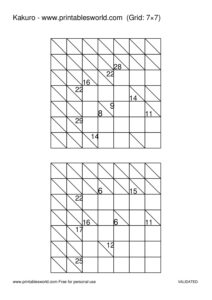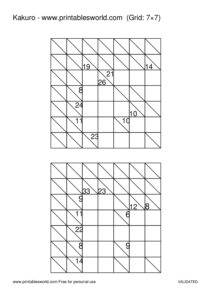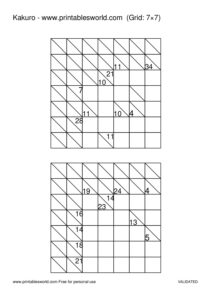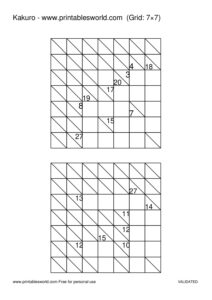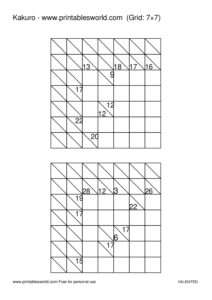Free kakuro printable pdfs download Easy, Medium and Hard Kakuro (Cross Sums) packs with solutions. Clean, ink-friendly grids in A4 and US Letter, ready to print at home or use in the classroom. Each PDF set includes an answer key so you can check your work or teach step-by-step. Click a pack to download instantly and start solving.
Free Kakuro Printable PDFs Downloads
Pick your difficulty below. We design every grid for clarity: bold outer borders, readable numbers, and enough white space for pencil notes. Most packs include both A4 and US Letter in the same download.
Easy Kakuro (great for beginners and warm-ups): Smaller grids with friendly totals and clear deductions.
Medium Kakuro (for regular solvers): Balanced challenge with a mix of straightforward and cross-checking sums.
Hard Kakuro (for experienced players): Larger grids, tighter combinations, and fewer “gimme” cells.
Mixed Difficulty Packs (variety set): A curated blend so you can build confidence, then ramp up.
Each printable includes solutions on a separate page. If you’re a teacher, you can hand out the puzzle first, then project or print the answer key for walkthroughs.
What is Kakuro (Cross Sums)?
Kakuro—sometimes called Cross Sums—combines the feel of a crossword with the logic of number combinations. Instead of letters, you place digits 1–9 into runs (across and down). Each run has a clue total, and you must fill the run with non-repeating digits that add up to that total. As runs intersect, the possibilities narrow, and a unique solution emerges.
Think of it as:
Sudoku’s logic (no repetition within a set),
Crossword’s layout (across/down entries), and
Mental arithmetic practice (totals and combinations).
Kakuro is brilliant for numeracy warm-ups, brain training, and quiet focus time.
How to Play Kakuro (Quick Guide)
Understand the clues: A small number at the corner of a shaded cell points across or down to indicate the required sum for the next run of white cells.
No repeating digits in a run: If a run is three cells long with a total of 17, valid sets include 9+8+0? (No—digits are 1–9 only) or 9+8+… actually 9+8 alone is already 17, so you’d look for three digits that make 17 without repeats (e.g., 9+7+1).
Use combination logic: Each total has limited combinations. For example, 4 in two cells must be 1+3; 16 in two cells must be 7+9.
Cross-check: When an across run intersects a down run, options for that cell must satisfy both sets’ possibilities.
Mark pencil candidates: Lightly note possible digits in a corner; erase as you eliminate options.
Propagate deductions: Placing one certain digit often forces other cells to become clear.
Common Sum Combinations (Handy Minisheet)
These are useful “must-use” combos because they’re either unique or very restricted:
2 cells: 3=1+2; 4=1+3; 16=7+9; 17=8+9.
3 cells (examples): 6=1+2+3; 7=1+2+4; 8=1+2+5 (or 1+3+4); 23=6+8+9; 24=7+8+9.
4 cells (edges): 10=1+2+3+4; 30=6+7+8+9.
Tip: The lowest totals tend to force small digits; the highest totals tend to force large digits. If you see a 2-cell run totalling 17, you know it’s 8+9 immediately.
Strategy Tips (From Easy to Hard)
Start with forced pairs: Runs like 4 in two cells (1+3) or 16 in two cells (7+9) give quick wins.
Scan for extremes: Very small or very large totals restrict options—great early anchors.
Use intersections early: A cell that belongs to both a tight across run and a tight down run often becomes a single possibility fast.
Track digit “pressure”: If a run must include a specific digit (e.g., only one way to reach the total without repeating), pencil it lightly; if intersecting runs confirm it, ink it.
Eliminate by impossibility: If placing a candidate would force duplication within a run or break another run’s total, strike it.
Step away, then return: Fresh eyes catch contradictions and easy placements you missed.
Printing & Classroom Tips
A4 & US Letter: Our free kakuro printable pdfs generally include both sizes; choose the one your printer prefers to avoid scaling blur.
Ink-friendly design: We keep backgrounds light, with clean line weight and high-contrast digits.
One puzzle per page (most sets): Plenty of room for notes. For eco-printing, try your printer’s 2-up option or our dedicated N-up versions when available.
Solutions on a separate page: Ideal for marking or classroom projection.
Laminating option: Slip puzzles into plastic sleeves and use dry-erase pens for repeat practice.
Who Are These For?
Puzzle fans wanting a calm, number-logic challenge.
Teachers & tutors looking for quick numeracy starters or extension tasks.
Homeschoolers building problem-solving stamina with light arithmetic.
Anyone who enjoys methodical, satisfying logic without long instructions.
Why Choose Our Free Kakuro Printable PDFs?
Clarity first: Grids are designed for legibility on home printers.
Ready in seconds: No sign-ups to download individual files.
With solutions: Perfect for self-checking or guided teaching.
Consistent difficulty: Easy, Medium, Hard, and Mixed packs so you always know what to expect.
Global-friendly: We offer A4 and US Letter whenever possible.
How We Recommend Using the Packs
Warm-up with Easy: Nail the fundamentals (forced pairs, small/large totals).
Move to Medium: Practise cross-checking and candidate elimination.
Try Hard: Tackle longer runs and tighter intersections for deeper logic.
Mix and match: Use Mixed packs when teaching a group with varied levels.
Track progress: Date your printouts, mark time-to-solve, and note strategies that helped.
FAQs (Kakuro Printables)
Are these free?
Yes—our free kakuro printable pdfs are free for personal use, and light classroom use is usually fine. Please check our Licence page for details.
Do you include solutions?
Absolutely. Each pack includes a separate solutions page.
What paper sizes do you provide?
Most downloads include A4 and US Letter. Check each file’s notes before printing.
Can I request a specific grid size or difficulty?
Yes—send a request via our contact form. We prioritise popular suggestions in upcoming packs.
May I use these in my small business or clinic?
Light, non-commercial handout use is often fine with attribution. Resale, redistribution, or claiming as your own is not permitted. See our Licence page for clear guidance.
More Logic Printables You Might Like
Sudoku: Daily, Medium, Hard, and Skilled levels with printable PDFs and solutions.
Nonogram (Picross): Black-and-white picture logic with clean, high-contrast grids.
Logic Grid Puzzles: Deduction tables and clues for deep reasoning practice.
Word Search: Themed sets for classrooms and rainy days.
Browse the full library for classroom maths sheets, colouring pages, flashcards, and more. If you enjoy these, sharing our pages or leaving a kind note really helps us reach more puzzle fans.
Printing Trouble-shooting (Quick Help)
Parts look cut off: Set scale to 100% or “Actual Size”. Disable “Fit to page” if it shrinks the grid too much.
Blurry lines: Ensure your PDF viewer isn’t compressing the print. Try Adobe Acrobat Reader or your browser’s native print.
Printer margins: If your printer forces large margins, choose the alternate paper size (A4 ↔ US Letter) or enable “shrink to fit” once.
Dark output: Use Draft/B&W mode; our designs are ink-friendly by default.
Contribute Ideas
Have a theme request, preferred grid size, or a classroom pack idea? Tell us what to make next. We read every message and regularly publish the most-requested packs.
